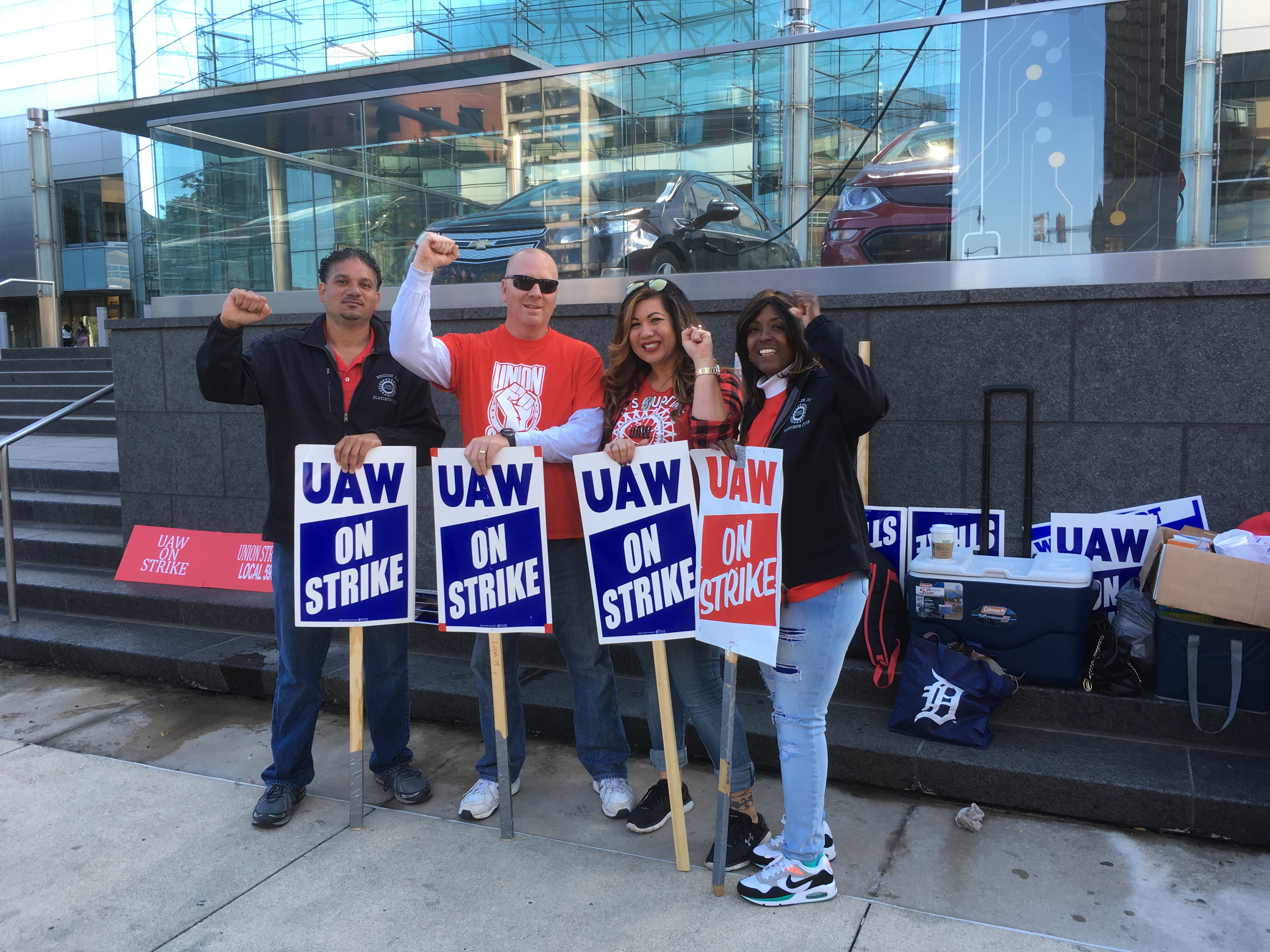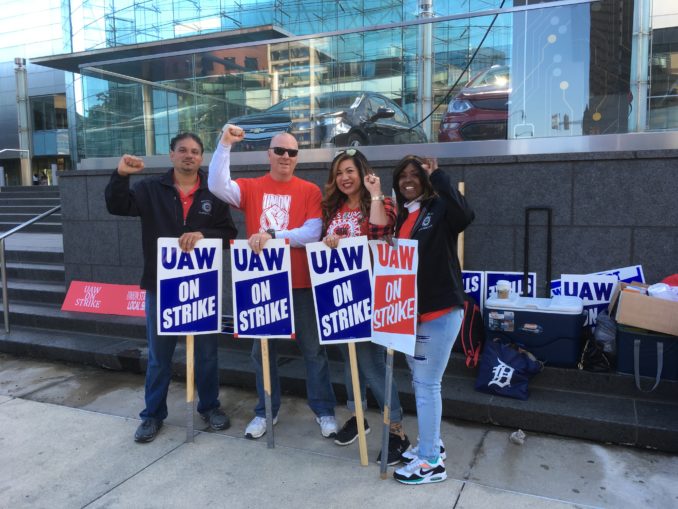

Strikers demonstrate outside GM world headquarters in downtown Detroit, Oct. 9
The 40-day strike of almost 50,000 General Motors workers came to an end on the afternoon of Friday, Oct. 25. The majority of striking United Auto Workers members voted to accept the contract agreed to by GM and union negotiators. The vote was 57 percent in favor, 43 percent opposed.
Under the previous four-year contract, the company had made about $35 billion in profit. At the strike’s onset, workers made it clear they wanted to win back what they had lost to “save” the company during its 2009 bankruptcy.


Rank-and-file strikers and supporters picket GM World Headquarters in downtown Detroit Oct. 9. (WW Photo: Martha Grevatt)
At that time a long list of concessions, given up by the workers two years into their existing contract with GM, were mandated by the U.S. Treasury to secure federal bailout money and keep the company afloat.
What, of all that was lost in 2009, did workers gain back in this contract go-around?
Basically nothing. The raises/bonus formula is close to that of the contract that just expired. The cost of living allowance was not restored. Before 2009, the company had to pay time and a half after eight hours worked in one day and on Saturday — not any more.
Three plants and one warehouse will be permanently closed. One that was slated to be closed, the Detroit-Hamtramck assembly plant (DHAM), will stay open and build a new electric truck. However, fewer workers are required to assemble electric vehicles than gas-powered vehicles. So while GM claims DHAM will retain 2,250 workers, the number could be smaller depending on sales; electric vehicles come with a high price tag.
Workers hired after October 2007 — second tier “in progression employees” — will make the same wages as higher-seniority workers by the end of the contract, but many of them will just be completing the ridiculously long eight-year wage progression from the previous contract. New hires will still be on the eight-year path to top pay — longer if they are laid off part of that time.
Some workers classified as “temporary employees” will be made permanent, but others could be locked in precarious status for an unknown period of time. The company can still hire new temporaries at a lower pay rate and with minimal benefits.
Four parts plants will continue to pay almost $10 an hour less than the rest of the company; parts warehouses have their own pay formula.
In other words, divisive multi-tier pay structures are an integral part of the union contract for another four years. This violates a basic principle that unions fought for in the past — equal pay for equal work.
Why did workers vote ‘yes’?
Under a different set of circumstances, workers might have turned the contract down and sent the negotiators back to the table to come up with a better deal. However, as the strike entered its sixth week, savings were being depleted, and the lowest-paid workers had none to begin with. For some, it was hard to turn up their nose at an $11,000 work bonus to be paid right off the bat.
Early reports from the negotiations stated that GM was pushing to hold raises down, raise health care costs substantially and do nothing whatsoever to improve the lot of temporary workers. If so, the strike pushed back these concessions.
The company utilized every means at its disposal, including the news media, to get workers to see its offer as a good deal. Detroit’s two daily newspapers ran stories every day, leading up to the final vote tally, extolling the virtues of the agreement. UAW leaders made the hard sell through a contract “summary” rather than encouraging every member to read some 350 pages of actual language.
There was no clear indication of what the consequences would be if the tentative agreement was rejected. Would workers stay on strike and for how long? What better deal, if any, would GM acquiesce to? Could the international leaders of the UAW be trusted to fight hard for workers, given the evidence of corruption and bribe-taking on the part of top leaders?
Fighting to make the union fight
Given these multiple factors, it is very significant that 43 percent of the strikers — about 17,500 votes — voted against the contract and were willing to extend the strike. A majority rejected the contract in at least 15 plants and warehouses, especially those with lower pay scales or plants slated to close.
The biggest achievement of the strike was the solidarity that grew out of the strike experience. Many rank-and-file militants emerged as leaders. Their main task now is to promote that same picket line solidarity inside the plants and hold management — along with corrupt or weak union leaders — accountable for any abuse, retaliation or disrespect the company tries to get away with.
The biggest strike in 12 years — the longest corporatewide auto strike since 1970 — has ended. But as teachers and education workers, hotel and fast food workers are demonstrating, the strike upsurge is not going away.
Boston, April 20, 2025 The leadership of the Democratic Party nationally and especially in Massachusetts…
Hamas – Islamic Resistance Movement made the following call, “Gaza cries out to you —…
The centennial of the birth of Malcolm X, also known as El-Hajj Malik El-Shabazz, is…
In a courageous act of solidarity with the Palestinian people, a Moroccan port workers’ union…
Buffalo, New York A large group of demonstrators marched on the Buffalo ICE (U.S. Immigration…
In the 1950s, when Japan and much of Europe was in ruins, the U.S. accounted…